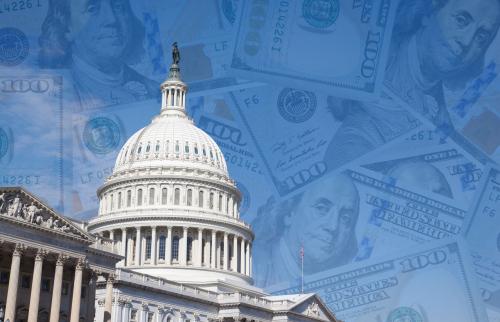Today, the Congressional Budget Office (CBO) released its complete score of the reconciliation bill that passed the House of Representatives last month by a one vote margin. CBO’s analysis reveals that the bill would reduce insurance coverage by 10.9 million people (for a total of 16 million, including coverage losses that are in CBO’s baseline) and reduce spending on federal health care programs by over $1 trillion. These impacts—and the consequences for the health care system—are similar in magnitude to those CBO expected to result from the Affordable Care Act (ACA) repeal bills that Congress considered in 2017. The projected reductions in federal spending on Medicaid and the ACA Marketplaces are between three-fifths to two-thirds as large (in relation to the projected size of the economy) as the ACA repeal bill that passed the House in 2017. And along key dimensions, CBO projects the 2025 bill to have a larger impact than the bill that Senator John McCain famously voted against in 2017.
This piece describes the major health care provisions of the House-passed reconciliation bill and places the projected impacts of those changes in the context of the changes considered in 2017.
What the House-passed bill does
The Affordable Care Act took three major steps to improve Americans access to health care: (1) improving the quality of private health insurance, including for the nearly 160 million people who get coverage through their jobs; (2) establishing the ACA Marketplaces with associated financial assistance so that Americans who do not get coverage at work or qualify for Medicaid would have an affordable source of health insurance; and (3) expanding and strengthening Medicaid so that the program would reach millions of additional people who would otherwise be uninsured. The House-passed bill would seriously weaken each of these three components of the law, even as it stops short of repealing most of these provisions outright.
Eroding protections in private health insurance
The House reconciliation bill would modify the ACA’s limits on annual out-of-pocket spending in private insurance plans by changing how that limit is updated over time. For the 2026 plan year, the bill allows health plans一including for people who have insurance through their jobs一to increase deductibles and other cost-sharing by up to $900 per year beyond the limits under the ACA today. While many private plans have limits on annual out-of-pocket spending below the legal maximum, some enrollees would face higher cost-sharing under this provision.
Weakening the ACA Marketplaces
The 2025 House-passed bill includes dozens of provisions that would make the ACA’s Marketplaces less effective at providing access to affordable coverage:
- New paperwork barriers: A variety of overlapping provisions would require ACA Marketplace enrollees to submit additional paperwork or take other administrative steps to get coverage or financial assistance. Described as an attempt to prevent fraud, these paperwork burdens are nonetheless likely to result in many eligible enrollees becoming uninsured. Examples include changes that would require 2.5 million additional people to submit paperwork proving their income, eliminating passive reenrollment (so that Marketplace coverage will not automatically renew on January 1), and offering consumers fewer and shorter windows to enroll.
- Cutting eligibility: Two groups would lose eligibility for coverage or financial assistance in the ACA Marketplaces: lawfully present immigrants under a variety of visa statuses, and people who are trying to resolve paperwork issues. This latter provision is particularly impactful in light of the large increase in administrative burdens generated by the provisions described above.
- Higher net costs: The House bill would make a number of changes to the way financial assistance is provided一so that the people who do not lose coverage will have to pay more for it. The bill increases the percent of income enrollees have to pay in premiums, allows plans to cover a smaller share of health care costs, and makes a financing change to certain federal subsidies that would have the effect of increasing premiums. In addition, the bill would allow higher premiums by failing to extend expiring enhancements to ACA financial assistance.
Taken together, CBO projects that these changes are expected to decrease Marketplace enrollment by about one-third. Thus, while the 2025 bill does not call for outright repeal of the ACA Marketplaces, it makes major changes that would markedly weaken the effectiveness of a program that has served nearly 50 million Americans over the last decade.
Deep cuts to Medicaid
The House-passed bill would cut Medicaid in a number of ways, some of which mirror how the bill cuts the ACA Marketplaces:
- New paperwork barriers: Millions of Medicaid enrollees would need to navigate new paperwork requirements to enroll or stay enrolled. This includes a requirement to report hours worked; similar past requirements have cut enrollment among those targeted by more than a third, with most of the coverage loss among those who are, in fact, ineligible, and merely having trouble documenting that fact.
- Higher net costs: States would be required to charge new cost-sharing for people with incomes just above the poverty line.
- Changes interacting with Medicare: Multiple provisions in the Medicaid sections of the bill affect seniors and other Medicare beneficiaries. It would require additional paperwork for people with Medicare seeking to become dually enrolled in Medicaid, which will reduce enrollment by more than 1 million. It also cuts lawfully present immigrants with certain visa statuses from Medicare. Further, it eliminates new safety protections for people in nursing homes.
- Financing changes: The House bill would prevent states from using certain types of “provider tax” arrangements in which states raise revenue by placing taxes on Medicaid-participating providers. This is projected to decrease federal spending, but will require states to cut enrollment, reduce benefits, or increase their own spending.
As above, these provisions are not an outright repeal of the ACA’s changes to Medicaid, but they would seriously weaken both the ACA Medicaid expansion and other components of Medicaid and amount to a very large cut to the program.
CBO estimates of the impact of the reconciliation bill compared to 2017 repeal efforts
The House reconciliation bill would have wide-ranging impacts on federal spending on health care, and the number of Americans who have health insurance. CBO estimates that:
- Federal spending on Medicaid will decrease by $806 billion over ten years.
- Federal spending on financial assistance for people buying coverage in the ACA Marketplaces will decrease by $301 billion over ten years.
The number of uninsured Americans will increase by 10.9 million in the long run compared to CBO’s baseline (which already assumes an additional 5.1 million people lose coverage after 2025 because of the expiration of ACA enhancements and other policies built into the baseline, for a total of 16 million).
These are large numbers, but in at least two ways, they understate the impact of the health care policies being pursued by Congress and the administration, particularly with respect to the Marketplaces. First, due to CBO’s conventions about how it scores legislative proposals that overlap with agency proposed rules, CBO’s score only counts half of the impact of some of the bill’s Marketplace policies. Prior information from CBO suggests that incorporating the full effects of these policy changes would increase the bill’s cuts to the Marketplace by at least $53 billion1 and the bill’s increase in the uninsured by 900,000. Second, CBO’s topline findings do not include the impact of a key policy choice made in this bill: declining to extend enhanced tax credits for people buying Marketplace health insurance that expire at the end of the year, even as the bill would extend other tax policies that are set to expire in 2025. Judging the bill relative to a baseline in which those enhancements continue would, according to CBO, increase the bill’s reduction in Marketplace spending by $335 billion and raise the bill’s impact on the uninsured by 4.2 million.
One way to understand the magnitude of these potential changes to the health care system is to compare them to the changes Congress contemplated during the 2017 ACA repeal debate. One bill Congress considered during that period was the American Health Care Act, which passed the House in May 2017 and would have repealed major sections of the ACA. Another was the Healthcare Freedom Act, a more modest bill whose primary feature was repeal of the ACA’s individual mandate; this was the bill that was ultimately voted down in the Senate in July 2017 when Senator John McCain offered his famous “thumbs down.” At the time, the July 2017 Senate bill was termed “skinny repeal.” Leadership in both chambers hoped the Senate would pass the relatively small bill and proceed to conference with the House in hopes of producing a bill that, while likely more limited than the House, would go beyond the Senate’s bill. Thus, when Senators voted on the Healthcare Freedom Act, they were formally voting on that specific bill but also lending their vote to continued discussion with the House. Taken together, one can understand these two pieces of legislation as poles in the summer 2017 policy debate that failed to produce legislation repealing the ACA.2 (Congress would ultimately repeal the ACA’s individual mandate in the December 2017 tax bill.)
The CBO score of the current bill and these 2017 proposals can be used to compare the effects of the 2025 bill to those of the 2017 proposals across three dimensions: the reduction in federal spending on Medicaid, the reduction in federal spending on financial assistance in the ACA Marketplaces, and the increase in the uninsured. To facilitate apples-to-apples comparisons of spending amounts (which concern different time periods and incorporate different underlying economic assumptions), the amounts reported for the 2017 bills have been adjusted so that they represent the same share of projected gross domestic product (GDP) under CBO’s current GDP projections as in CBO’s original estimates. To illustrate the full impact of potential looming changes to the health care system, I also present estimates that encompass both the effects of the House-passed bill and the pending expiration of the enhanced premium tax credits, as well as the Marketplace changes in the baseline.
Across all three metrics, the effects of the House-passed bill are of a similar magnitude to the 2017 policies. The current House-passed bill would reduce federal spending on Medicaid by three-fifths as much as the House’s 2017 ACA repeal bill, and it would reduce federal spending on the Marketplace by two-thirds as much as the 2017 House bill. Including the impact of the expiring tax credit enhancements that the 2025 Congress is declining to extend and the Marketplace policies included in the baseline, CBO projects an impact to the ACA Marketplaces that is, in fact, greater in 2025 than the House’s comprehensive 2017 ACA repeal bill. Comparisons to the 2017 Senate bill are even starker, with the 2025 House-passed bill greatly exceeding 2017’s “skinny repeal.” Examining the impact on the number of uninsured also shows that the current bill would have effects of the same broad magnitude as the 2017 bills: the 2025 bill would increase the number of uninsured by roughly half as much as the 2017 House-passed bill, and roughly two thirds as much as the Senate bill, with current proposals looking commensurately larger when changes built into the baseline are included.
While much discussion of the 2025 legislation has focused on other aspects of the bill, especially the tax provisions, it is clear that this is a major piece of health legislation that would cause reductions in insurance coverage that Congress has一at least historically一ultimately shied away from enacting.
Ultimately, the 2017 ACA repeal effort failed over some Republican Senators’ unwillingness to inflict major cuts on the American health care system. The weeks ahead will determine whether that remains true in 2025.
-
Acknowledgements and disclosures
The author thanks Matt Fiedler for helpful comments, Chloe Zilkha, Yihan Shi, and Ben Graham for superb research assistance, and Rasa Siniakovas for editorial and web posting assistance. All errors are our own.
-
Footnotes
- CBO estimates that the relevant policies would reduce spending by $202 billion, of which $101 billion is included in the score. There is some interaction between this provision and other policies in the bill; assuming the full amount of the interaction between the health provisions in Titles IV and XI is attributable to interactions related to these policies (a conservative assumption) indicates there is at least $53 billion in additional impact.
- The Senate also discussed the Better Care Reconciliation Act, which was structured differently than the American Health Care Act but of similar magnitude and ambition.
The Brookings Institution is committed to quality, independence, and impact.
We are supported by a diverse array of funders. In line with our values and policies, each Brookings publication represents the sole views of its author(s).







Commentary
New CBO estimates show 2025 reconciliation bill would have impacts similar in magnitude to 2017 ACA repeal bills
June 4, 2025